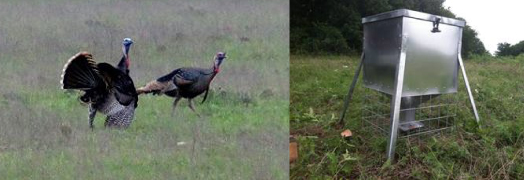While a key wildlife management activity is supplemental feeding, this doesn’t mean picking up deer corn at Tractor Supply and tossing it in the pasture. And supplemental food plots should not be considered an easy fix alternative to quality habitat management. Rather, smart wildlife management nurtures native vegetation from grasses to forbs to trees, all of which will have greater long-term benefits than any supplemental feeding or planting but, whether due to nature or man-made malady, sometimes ― particularly during critical periods ― we need to give nature a boost.
Feeders and Feed
From a 2-pound songbird bird feeder to a 200–pound turkey feeder, well-placed supplemental feeders are a relatively easy and effective way to provide supplemental food for birds, but they’re definitely not “set it and forget it.” Once you start feeding this way, it is very important that you keep it up and in good shape. Make sure your feeders are kept full and cleaned regularly to avoid contamination from aflatoxin. As the name indicates, aflatoxin is a toxic chemical produced by a mold that grows on grains. When consumed in sufficient doses, aflatoxin may reduce egg production, suppress immune response, and even kill. The aflatoxin mold grows best in moist, warm conditions, so storing your feed properly and keeping it as dry as possible while in feeders are key preventive measures.
In the case of deer, management populations is a much higher priority than providing supplemental food. For most wildlife managers, feeders for deer should not be used except during “stress periods” and, then, only under specific conditions such as during a drought when protein content of forage is low. Further, unless properly done, the supplemental feeding of deer is of little or no value thanks to the poor nutritional value of corn, the most popular deer feed used throughout most of Texas. It is low in protein ― what the deer actually need ― and high in carbohydrates. Again, the best strategy for keeping your deer – and all wildlife – properly fed is a wildlife management strategy that nurtures native vegetation. For more information on supplemental feeding of deer, check out Supplemental Feeding by J.R. Perkins published by Texas Parks and Wildlife.
Food Plots
Even those with the best efforts and intentions when it comes to managing native vegetation know that off-and-on-and-on Texas drought does not always allow for plentiful food for wildlife. Food plots provide both attractive and nutritious supplemental food to assist the native food supplies. When choosing an area for your food plot, select a site that is open and tillable but also near cover. To reduce competition with trees, try to maintain a nice distance from any woodland edge. Look for flat ridge tops, bottom lands, or along the contour of a gentle slope for establishing your food plot. If there’s a down side of food plots in Texas, it is that they are often productive during wet conditions when they may not be needed and unproductive during droughts when they are needed most.
For an all-purpose plot that will appeal to deer, turkey, and quail, planting legumes with a thin stand of grass will provide both green forage as well as plentiful insects for turkey and quail. An example food plot might be a mixture of grasses that include oats, wheat, and triticale and legumes such as hairy vetch, Austrian winter peas, alfalfa, and hubam clover. For more information the why and what of food plots, check out Food Plots For White-tailed Deer.
In a perfect world, we wouldn’t need to engage in supplemental feeding, but if the goal is protect and nurture our native Texas wildlife then thoughtful, well-considered supplemental feeding will remain a key wildlife management activity.









